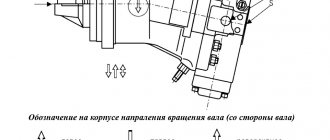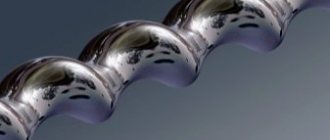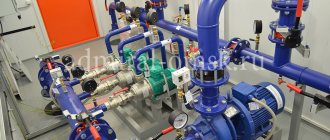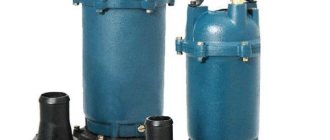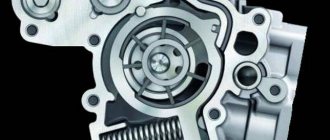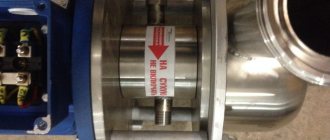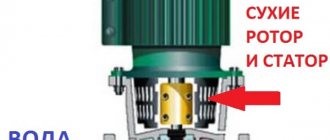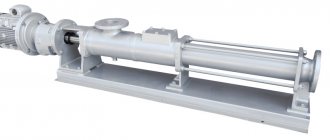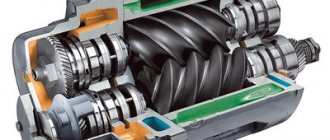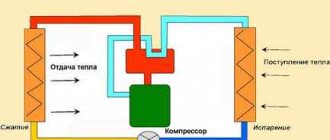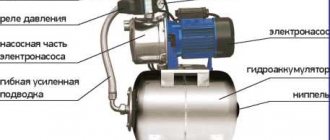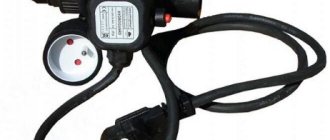What is an axial piston type hydraulic pump?
An axial piston hydraulic pump, like a radial piston one, is a positive displacement device that operates by changing the volume of the working chambers. In hydraulic pumps of the axial piston group, such working chambers are formed by borings, which are made in a cylindrical block. Unlike radial piston pumps, axial piston machines have internal working chambers located parallel to the pistons and the axis of the device itself. As the pistons of such a pump move and the cylindrical block rotates, the volume of the working chambers increases or decreases, which allows the device to suck in and release the liquid it pumps.
Sectional view of axial piston pump
Like radial piston pumps, the working chambers of axial piston devices are connected to suction and discharge pipes, through which the pumped water is taken in and released. The process of connecting the working chambers with the suction and discharge pipes of pumps belonging to the axial piston group occurs in stages. In terms of how an axial piston type hydraulic pump works, it is similar to steam and radial piston pumps.
Hydraulic motor: device, purpose, principle of operation
Since ancient times, hydraulic mechanisms have been used by mankind in solving various economic and engineering problems. The use of energy from fluid flows and pressure is still relevant today. The standard hydraulic motor design is designed to transfer the converted energy into force acting on the working link. The very scheme of organizing this process and the technical and structural nuances of the unit’s execution have many differences from conventional electric motors, which is reflected in both the pros and cons of hydraulic systems.
Design of a hydraulic axial piston pump
- Design of a hydraulic axial piston pump
- Where is it used?
- Device and principle of operation
- Types of axial piston pumps
- What are they?
An axial piston pump is a device capable of converting the mechanical energy of circular rotation of a shaft into the energy of fluid movement; the pistons in such a device are located parallel to the axis of rotation.
Axial piston pumps can also be used as a hydraulic motor; if liquid is supplied from the reverse side, we get shaft rotation. This feature of these devices ensured their maximum distribution.
Design features and principle of operation
The axial piston type hydraulic pump consists of the following elements:
- pistons, also called plungers, which are part of the cylinder block;
- connecting rod type elements;
- drive shaft, which is also called the main shaft;
- mechanism that performs distribution functions.
Design of an axial piston pump with an inclined block
The principle by which an axial-type piston hydraulic pump operates is based on the fact that its main shaft, when rotating, imparts movement to the elements of the cylinder block. The rotation of the main shaft of axial piston type pumps is converted into reciprocating movement of the pistons, performed parallel to the axis of the cylinder block. It is due to the nature of such piston movements, which are axial, that the pump got its name.
Operating principle of an axial piston hydraulic pump
As a result of the movement performed by the pistons in the cylinders of the axial plunger pump, alternate suction and subsequent injection of liquid occurs through the corresponding nozzles. The connection of the working chamber of the pump with its suction and discharge lines occurs sequentially, using special windows made in the distribution mechanism. To minimize the risk of malfunctions during the operation of the cylinder block of axial-piston type hydraulic pumps, as well as to ensure reliable operation of such a device, its distribution mechanism is pressed as tightly as possible to the cylinder block, and the windows of such a block are separated from each other by special sealing gaskets. Throttle grooves are made on the inner surface of the windows of the distribution mechanism, the presence of which makes it possible to reduce the amount of hydraulic shock that occurs in the pipeline system during pump operation. The presence of such grooves on the inner surface of the windows of the distribution mechanism helps to increase the pressure of the working fluid created in the cylinders as smoothly as possible.
As it becomes clear from the above-described design of an axial piston hydraulic pump, its working chambers are cylinders located parallel (axially) to the axis of its rotor, and the displacement of liquid from such cylinders is carried out due to the reciprocating movements of the piston.
Pump operating principle
Displacers in axial piston machines can be pistons or plungers .
Read also: Making a machine for sharpening drills at home: making a sharpener with your own hands
Pumps with plungers are sometimes called axial plunger . However, often the names do not reflect this feature, and the pump is called axial piston , regardless of whether the displacer is a piston or a plunger.
In axial piston pumps with an inclined block, the axes of the working bodies are at an angle to the axis of the drive shaft. This angle determines the stroke of the pistons. Its value is less than 45°. In most designs, the angle of inclination is 20°-30°.
When the shaft rotates, the rotor or cylinder block is also driven into rotation through pistons pivotally mounted on the drive shaft.
The rotor is pressed against the spherical surface of the distribution disk, on which two crescent-shaped grooves are made.
When the drive shaft rotates, each of the pistons moves in the rotor holes. The amount of movement depends on the angle of inclination of the block.
When the piston moves, increasing the volume of the working chamber, liquid is sucked through the crescent-shaped groove and fills the chamber.
When the piston moves in the opposite direction, the volume of the working chamber decreases. The liquid is forced out through another crescent-shaped groove. The holes in the rotor in which the pistons move are evenly distributed. At that moment, while some pistons are displacing liquid, others are moving in the opposite direction. This ensures a continuous supply of pump fluid with significantly reduced pulsations.
In axial piston pumps with an inclined disk, the axes of the working elements are parallel to the axis of the drive shaft. The movement of pistons or plungers inside the rotor is ensured by an inclined disk on which the plungers rest through pushers.
The rotor is fixed to the shaft with a key, therefore, when the drive shaft rotates, the rotor rotates, and with it the plungers.
Read also: Simple potato hiller from an old bicycle: do it yourself
The plungers, when the drive shaft rotates, move in the rotor holes.
As the working chamber increases, liquid fills it. When the plunger moves in the opposite direction, liquid is forced into the pressure line.
Advantages and disadvantages
An axial piston hydraulic motor and hydraulic pump of this type, when compared with radial and steam devices, have the following advantages:
- With a fairly compact size and light weight, such devices have impressive power and decent performance.
- Due to their compact size and light weight, pumps of the axial piston type create a small moment of inertia during operation.
- The rotation speed of the output shaft of an axial piston hydraulic motor is very easy to adjust.
- These devices operate effectively even at a sufficiently high pressure of the working fluid and at the same time create the appropriate torque of the output shaft.
- In such installations, it is possible to change the volume of the working chamber, which cannot be achieved when using hydraulic pumps and radial piston hydraulic motors.
- The frequency with which the output shaft of hydraulic motors of this type rotates, depending on the model, can be in the range of 500–4000 rpm.
- Unlike radial piston pumps, which can operate at a working fluid pressure not exceeding 30 MPa, axial units are capable of operating at a pressure reaching 35–40 MPa. In this case, the loss of such pressure will be only 3–5%.
- Since the pistons of axial pumps are installed in the working chambers with minimal clearances, high tightness of such installations is achieved.
- When using pumps of this type, both the direction of flow and the pressure of the working fluid can be adjusted.
Adjustable axial piston hydraulic motor used on loaders, excavators and truck cranes
Like any other technical device, axial piston pumps have disadvantages:
- Such pumps are quite expensive.
- The complexity of the design makes it much more difficult to repair axial piston hydraulic pumps.
- Due to the not very high reliability, hydraulic mechanisms of this type should be operated only according to the instructions, otherwise you may encounter not only the low efficiency of such a device, but also its frequent breakdowns.
- When using pumping equipment of this type, liquid is supplied to the hydraulic system with large pulsations and, accordingly, is consumed unevenly.
- Due to the high pulsation characteristic of the operation of such pumps, the hydraulics with which the pipeline system is equipped may not work correctly.
- Hydraulic mechanisms of the axial piston type react very critically to a contaminated working environment, so they can only be used with filters whose cell size does not exceed 10 microns.
- Axial-piston hydraulic devices, due to the peculiarities of their design, produce significantly more noise during operation than models of pumps and hydraulic motors of the vane and gear type.
The axial piston type, as mentioned above, can include not only hydraulic pumps, but also hydraulic motors. The operating principle of the hydraulic motor is almost identical to the operating principle of an axial piston pump. The main difference is that such work is performed in the reverse order: liquid is supplied to the device under a certain pressure, which forces the pistons of the hydraulic motor to move, causing its output shaft to rotate.
Varieties
Unlike steam and radial piston pumps, axial-type units are divided into two types:
- Axial piston equipment with swashplate. For such devices, the drive shaft is connected to a cylindrical tank and mounted on bearings. The working chambers contain pistons that rest on a swashplate. The working surface of this washer, in turn, forms a perpendicular to the axis of the block with the cylinders. Due to this angle of inclination, during rotational movements of the rotor, the pistons perform reciprocating movements. Due to this, the volume of the chambers increases or decreases. This facilitates the suction or expulsion of water through the hole in the distribution disc. To get an adjustable pump, you need to change the angle of the washer. Thanks to this, the unit will change the fluid supply. To change the direction of water supply, it is necessary to adjust the reverse tilt of the cylindrical block relative to the vertical of the drive shaft. This is how the water supply is reversed. Thanks to this principle of operation, the suction and discharge pipelines do not change places. Units of this type are typically used for medium to heavy duty applications.
- Axial piston product with an inclined block. In such pumps, in contrast to the steam and radial piston units, the drive shaft is made in the shape of the letter “T”. It is mounted in angular contact bearings. The cylinder block, in turn, rests on a separate axis and is located at a certain angle to the shaft axis. The cylindrical block has several axial bores in which the pistons are located. They are connected to the shaft via connecting rods. When the shaft rotates, the cylindrical block also moves due to the transmission of motion through pistons and connecting rods. The design and operating principle of this axial pump are based on the fact that, due to the angle between the shaft and the cylinder block, some of the pistons will come out of the rotor, while the other part will be able to move in. Due to this action, the volume of the working chambers will decrease or increase, causing the injection or suction of water. To suction and supply the aqueous medium, a special window is used in the bottom of the cylindrical block, as well as a hole in the distribution disk. Then the water moves through the channels in the housing of the pumping equipment. Unlike a steam and radial piston pump, in such an axial unit it is possible to change the stroke of the pistons. To do this, it is necessary to change the angle of inclination of the cylindrical block. This will contribute to a change in the working volume of pumping equipment. Such units can be called controlled-feed equipment.
Main disadvantages
Along with numerous advantages, there are also a number of serious disadvantages. When selecting an axial piston pump, it is important to consider the following features of the device:
Design of an unregulated axial piston pump
- very high price;
- complex design complicates maintenance and repair work;
- if used incorrectly, frequent breakdowns are possible, which indicates low reliability;
- water supply occurs unevenly, with large pulsations;
- supply pulsation occurs throughout the entire water supply system served by such a mechanism;
- the complexity of the design implies lengthy repairs in case of breakdowns;
- the need to purify the working fluid from impurities larger than 10 micrometers;
- high noise during operation.
Related video: Testing an axial piston hydraulic pump
Repair of equipment
The unit with closed holes is removed and washed with kerosene. Next, each individual pump element must be cleaned with a soda solution. To repair the holes of a cylindrical block, a special tool is used - a split cast iron lap. A mixture of diamond powder, oleic acid and stearin is applied to it. Pistons lubricated with industrial oil are processed without the use of abrasive pastes.
To restore the spherical surface of the cylinders, grinding is used on a specific machine. The end is restored by grinding the main holes with corundum stone and diamond powder. The work surface is repaired in the same way. When restoring the structure, you must make sure that all parts are cleaned of dirt and corrosion, and also lubricated with a special liquid.
Under the following circumstances, repair of faults is not possible:
- If the pump body, flange or door is cracked, dented or chipped.
- Deep scratches on the surface of the cylindrical block or the support axis do not allow repairs.
- If distortions are found on the connecting rods and pistons, restoration is impossible.
